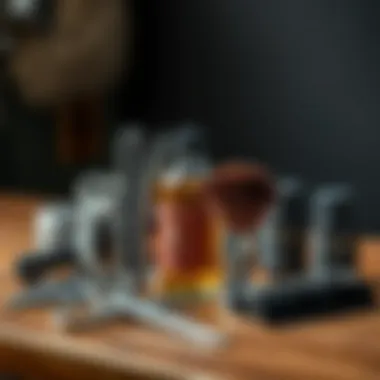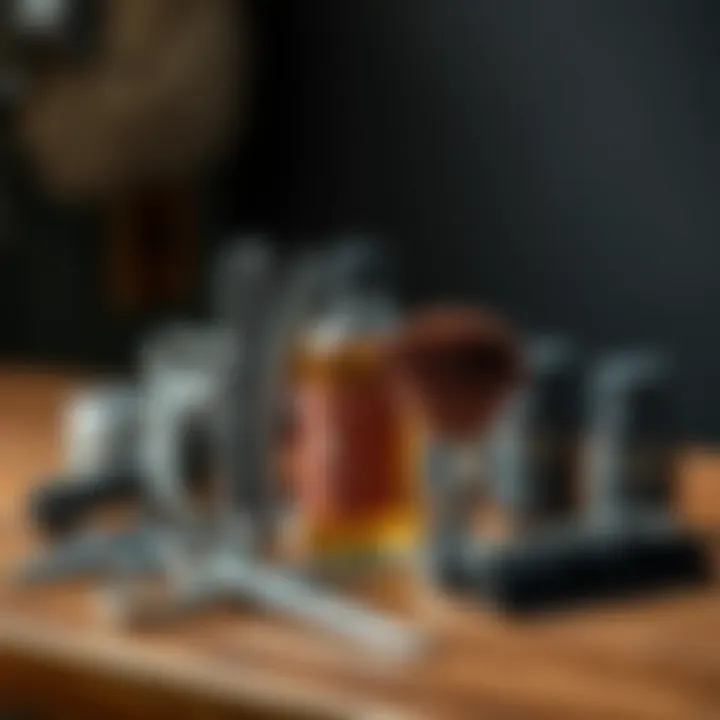Mastering Beard Shaping: Tools and Techniques


Intro
A well-shaped beard can elevate your appearance, acting like a frame for your face. It’s not merely about growing facial hair; it’s an art form that requires tools, techniques, and a bit of flair. Understanding how to shape and style your beard can make a world of difference in how you present yourself. This article explores the various tools available for beard grooming and discusses the harmonious blend of aesthetics and skill in achieving that perfect look.
Beard grooming isn't a passing trend; it’s become a pivotal part of modern masculinity. Men are no longer bound by the classic norms of grooming. Instead, many embrace individuality, using their beard style to express personality. However, achieving that polished style takes more than just a good brush and a bit of wax. There’s a plethora of tools tailored for various styles and needs.
Tools like trimmers, brushes, and combs play an essential role. A quality trimmer can determine the difference between a well-defined beard and a disheveled look. Meanwhile, brushes help to manage frizz and ensure every hair falls into place.
In this article, readers can expect to gain insights into the significant role of proper tools in the shaping process, each serving distinct functions that can enhance or detract from your overall grooming routine. Whether you're a grooming novice or a seasoned beard aficionado, understanding these elements is crucial for cultivating a look that commands attention, yet feels authentically you.
As we peel back the layers of beard grooming, we will introduce the tools that help achieve a desired style, maintenance practices vital for keeping your beard in check, and the latest trends that make every guy look dapper. Brace yourself for a comprehensive guide, giving you the tools needed to not just grow a beard but to shape an identity.
Intro to Beard Grooming
Beard grooming isn’t merely an act of maintaining facial hair but a profound practice embedded in style, culture, and personal expression. The importance of this topic lies in its multifaceted nature, where historical context and cultural significance interweave, shedding light on the ways in which men present themselves to the world. In our busy lives, achieving a well-groomed look can feel like a personal triumph, a small victory amid chaotic routines.
Adopting a thorough grooming regimen has become increasingly valuable, not only for aesthetics but also for self-assuredness. A well-kept beard can reflect diligence, attention to detail, and a keen sense of personal style. It's not just about growing hair, but sculpting it to enhance features and convey a particular image.
With the emergence of specialized tools and products in this field, the art of beard grooming has transformed into a science. This article aims to provide a comprehensive overview of beard grooming and styling, starting from the historical notions that shaped its significance, to today’s trends that emphasize both style and practicality. Through an examination of tools, techniques, and maintenance, we will explore how these aspects contribute to the intricate dance of grooming that many men engage in today.
Historical Perspective
From the early days of civilization, beards have carried meanings that vary across cultures and eras. Ancient Egyptians, for instance, saw beards as symbols of status and wisdom, often adorning them with jewelry to signify their importance. Meanwhile, in Norse cultures, beard length was tied to masculinity and valor, a badge of honor reflecting one's prowess in battle.
In more recent history, the Industrial Revolution brought about significant changes, both socially and regarding grooming practices. As men began to spend more time in professional environments, the beard became an accessory of distinction, yet demanding meticulous care. Famous figures, such as Charles Dickens and Abraham Lincoln, sported beards that established a paradigm of fashion and gravitas, influencing societal norms for grooming.
Beards also ebb and flow in popularity, often shaped by cultural movements and protests against conformity. The hippie movement of the 1960s embraced natural looks, including unkempt beards, serving as expressions of freedom and rebellion. Today, the current fascination with hipster culture reintroduces well-groomed yet tousled beards, marrying historical relevance with modern trends.
Cultural Significance
In many societies, beards symbolize far more than mere hair growth. They carry connotations of power, maturity, and masculinity. Consider the luxurious goatees woven into the fabric of cultures—from the wise men of Judaism to the iconic figures within Islam; every culture nuances its meaning, enhancing its richness.
Furthermore, the significance of beards transcends mere appearance; they often serve as discussion points in broader conversations around identity and societal roles. The act of grooming oneself often signifies confidence and self-respect, contributing to one's character. Whether a man chooses to sport a full beard or opts for a clean shave, it reflects personal choice and, at times, social commentary.
In browser conversations, social media platforms like Facebook and Reddit foster communities centered around beard grooming. Users share tips on maintenance, while also celebrating individuality and community engagement. With the dawn of influencer culture, it has become common for grooming products to be marketed as lifestyle essentials, showcasing the cultural evolution surrounding beard grooming.
Understanding Beard Shaping Tools
When it comes to maintaining a beard, the right tools are half the battle won. Understanding beard shaping tools is vital for any grooming enthusiast and can drastically influence the overall effect a well-maintained beard has on one's appearance. An array of specialized tools exists, each designed to tackle specific aspects of the beard grooming process.
From the moment you decide to shape or style your beard, the choice of tools can make a world of difference. The correct tool can help achieve a clean, polished look while ensuring comfort during the grooming process. Let's dive in.
Types of Tools
Beard Trimmers
Beard trimmers are akin to a trusty Swiss Army knife in a person's grooming arsenal. They come equipped with various length settings that allow for precision cutting, making it much easier to maintain a uniform length across your beard. The versatility of beard trimmers cannot be overstated; whether you're looking to achieve a subtle fade or a sharp outline, these devices are invaluable.
One of the key characteristics of beard trimmers is their ease of use. Many models come with self-sharpening blades that can glide through hair without pulling or snagging, which offers a smoother experience. One potential downside, however, can be the maintenance of battery life in cordless options. A forgotten charge can leave you in a lurch mid-groom.
Scissors


While trimmers dominate most conversations around beard grooming, scissors have a crucial role that should not be overlooked. They provide a direct method for targeted cutting, making them ideal for tackling stray hairs or refining the edges of your beard. This tool allows for a fine touch that trimmers simply cannot replicate.
A notable characteristic of scissors is their simplicity. They require no power and are, therefore, always ready for action. However, using scissors requires practice, as improper technique can lead to uneven cuts or accidental snips. Overall, scissors are a favorite among those who prefer a more artisanal approach to beard grooming.
Combs
When it comes to achieving a well-groomed beard, combs play a crucial supporting role. They help detangle hair while also aiding in styling and spreading products evenly. Combing regularly can also help train stray hairs to fall in line, ensuring a tidy look.
The defining feature of a quality comb lies in its material. Wooden combs, for example, reduce static and are gentle on hair, making them a significant choice for those who wish to minimize damage. The disadvantage, however, is that they might not provide the same styling hold as a good styling paste. Still, they serve as an effective bridge between grooming and styling.
Razors
For that sharp, clean neckline, razors are essential. A well-placed razor can create a crisp line that defines the face or neck area, giving the overall beard a clean finish. Ultimately, razors are vital in ensuring that a beard looks intentional and well-maintained.
Among the notable features of razors are their precision and the close shave they provide. Using a good razor can lead to a clean and polished look that many beard enthusiasts strive for. On the flip side, improper use can lead to nicks or irritation on the skin. Careful technique is paramount when wielding this powerful tool.
Essential Features
Blade Quality
Understanding blade quality is crucial in the pursuit of effective beard grooming. A high-quality blade enables clean cuts and reduces the risk of tugging hair. The sharpness of the blade significantly affects the quality of your trimming or shaving experience; a dull blade can lead to frustration.
Typically, stainless steel blades are celebrated for their durability and resistance to corrosion. However, they can require regular maintenance to ensure optimal functionality, which might be a downside if you're looking for something low-maintenance. A sharp blade ultimately leads to better results.
Ergonomics
The shape and feel of the grooming tools you choose significantly impact the user experience. Ergonomically designed tools can reduce strain on your hands and allow for better control, especially during lengthy grooming sessions. A comfortable grip can enhance precision, making each cut intentional.
A key feature in ergonomically designed products is their balance. The weight distribution ensures that users do not have to exert excessive force, leading to fewer mishaps. Nonetheless, ergonomic tools often come at a higher price, making them a consideration for the budget-conscious.
Versatility
In a world where space and functionality can be a concern, versatility in grooming tools is an attractive characteristic. Multi-purpose tools allow users to achieve various styles without needing to invest in multiple products. This can save not only money but also counter space.
The adaptability of high-quality grooming tools means that they can be suitable for different beard lengths and styles. However, these versatile options might sometimes sacrifice specialized functions, which can be a consideration for those focused on precision styling.
Regardless of the grooming path you choose, understanding the appropriate tools and their features ensures that you can achieve a look that underscores your personal style.
Techniques for Effective Beard Shaping
When it comes to grooming, techniques play a crucial role in achieving that perfect beard shape. Mastering these can be the difference between looking sharp and looking scruffy. Effective beard shaping is not merely about having the right tools but understanding how to use them. The right techniques enhance not just the look of the beard but also boost confidence. Here, we will dive into the steps involved in preparing, shaping, and maintaining your beard with clarity and purpose.
Preparation Steps
Cleaning the Beard
Cleaning the beard is the foundation of effective grooming. Think of it as prepping a canvas before painting. Without a clean surface, all efforts can go in vain. This process removes dirt, oil, and any product buildup that can hindering the shape. A warm water rinse followed by a quality beard shampoo ensures that the hair is free from impurities. Good cleaning is often undervalued; however, it provides a healthier environment for subsequent treatments like conditioning and shaping. Not only does it offer immediate benefits, but it can also contribute to better hair health in the long run.
Assessing Beard Type
Recognizing your beard type acts as a roadmap for what techniques will work best for you. Different beard types — whether coarse, fine, curly, or straight — require different strategies and care. For example, a fine beard might necessitate gentle shaping while a coarse beard might afford a bit more freedom. Understanding your beard type helps in determining the right tools and products. This assessment can save time and prevent frustrations by steering clear of unsuitable methods.


Shaping Techniques
Outline Methodology
The outline method is crucial in attaining a defined shape. It involves starting with the big picture before zeroing in on the details. This means deciding on the overall silhouette of the beard before moving to precise lines. The outline serves as a frame, ensuring that the final shape complements the contours of the face. This method is favored by many as it makes the final result more coherent. However, without a solid outline, one risks going back and forth, wasting time.
Detailing Techniques
Once the outline is set, detailing comes into play to elevate the overall appearance. Detailing focuses on refining edges and achieving a polished look. This might involve using finer scissors or an edger to ensure clean cuts and defined lines. This step is where the artistry lies; those intricate details can make a world of difference. On the flip side, one must approach detailing carefully as overdoing it can lead to unevenness.
Post-Shape Maintenance
Conditioning
Conditioning is just as important as the shaping process itself. A well-conditioned beard is softer, easier to style, and tends to look more vibrant. Regular conditioning, preferably with a quality beard conditioner or oil, nourishes the hair and reduces itchiness. This practice promotes healthier growth and helps retain shape. However, it's essential to avoid over-condition, as it can lead to a greasy look.
Regular Trimming
Consistency is key in beard maintenance, and regular trimming is a crucial component of that routine. This shouldn't just be seen as a chore but as an act of care. Trimming helps in removing split ends, maintaining the overall shape, and ensuring that growth is encouraged in the right direction. However, it's essential to strike a balance; too much trimming can undo the hard work already accomplished in shaping the beard.
The techniques used in beard shaping and maintenance are not merely steps on a checklist; they are the criteria that demarcate a well-groomed individual from the rest.
Employing these techniques thoroughly will not only enhance the look but also improve your overall grooming game. Understanding these different but interconnected steps creates a harmonious experience, leading to a confident exterior that reflects good grooming habits.
Key Factors to Consider When Choosing Tools
Selecting the right tools for beard shaping is pivotal. The choices can significantly influence the grooming experience and outcome. It’s not just about aesthetics; it's about functionality, ease of use, and durability. Each tool contributes to achieving and maintaining a well-groomed appearance, making careful consideration essential.
Budget Considerations
Price often holds sway in decision-making. While some may think that a higher price tag guarantees better quality, this not always the case. It’s possible to find effective tools at various price points.
- Quality vs. Cost: You should focus on what you get for your money. A more affordable trimmer doesn't automatically mean it's subpar; sometimes, you can strike gold with a lesser-known brand.
- Initial vs. Long-Term Investment: Take into account how often you’ll use the tool. If you're a daily groomer, spending a bit more for a sturdy trimmer can be worthwhile. On the other hand, if you only groom a few times a month, a budget-friendly option might suffice.
- Accessories and Maintenance Costs: Don’t just look at the upfront price. Also, consider the longevity of the product. Replacement blades or charger components can add up. See if the brand offers attractive warranty options, making the long game more cost-effective.
Brand Reputation
The name on the packaging can sometimes be a telling sign of reliability. A reputable brand often signifies a history of quality, but not every shiny logo lives up to expectations.
- Research and Recommendations: Don’t judge a book by its cover. Dig deeper into reviews and audience opinions. Websites like Reddit can provide insights from everyday consumers, while niche grooming forums may offer expert advice. A simple search can unveil experiences and recommendations.
- Established vs. Up-and-Coming Brands: While big names like Wahl and Philips have proven track records, newer players like Bevel are making waves with innovative offerings. Trying less-established brands might offer unique features at a fraction of the cost.
- Customer Service and Availability: Pay attention to a brand's customer service reputation, which can be a deal breaker. Fast responses and easy access to replacement parts can save you headaches down the line.
In sum, choosing the right tools requires a combination of assessing your budget and understanding brand reputation. By taking care to consider these factors, you can enhance your grooming routine, making it efficient and enjoyable.
Current Trends in Beard Grooming
In the ever-evolving world of personal grooming, beard styling has captured the attention of many, becoming not merely a trend but a cultural staple. Today's grooming enthusiasts are not only looking to maintain a beard but striving to elevate the grooming ritual into an art form.
Understanding current trends in beard grooming is vital because it reflects broader societal shifts in self-expression and personal care. With the rise of social media, images of impeccably styled beards flood our feeds, influencing choices and encouraging men everywhere to invest more time and energy into their facial hair. The right tools and products can amplify that allure, adding to one's overall grooming regimen. Keeping an eye on trends lays the groundwork for informed choices that enhance personal style.
Grooming Products
Beard Oils


Beard oils have become synonymous with quality grooming. The primary purpose of beard oil is to hydrate both the hair and the skin beneath it, preventing itchiness and flaking. A key characteristic of these oils is their blend of carrier and essential oils, providing nourishment while imparting a pleasant scent. This option has gained popularity because many men appreciate not only the hydration benefits but also the ease of use.
One standout feature is the lightweight nature of beard oils, allowing for quick absorption without leaving a greasy residue. Users often notice softer facial hair as well as increased control, facilitating styling. However, it’s important to choose oils that don’t contain harsh chemicals which can irritate sensitive skin.
Balms
Beard balms serve a dual purpose: they moisturize and style. The key characteristic here lies in their thicker consistency compared to oils, thanks to the inclusion of beeswax or butters, allowing for greater hold in styling. Many find them to be a beneficial choice for those with longer beards, as they tame fly-aways and provide a cleaner finish.
The unique feature of balms is their ability to give structure and shape to the beard while simultaneously nourishing it. However, their heavier texture can make them a less appealing choice for individuals seeking a quick, refreshing application.
Styling Pastes
When it comes to dynamic styles, beard styling pastes are gaining traction. This relatively newer product offers flexibility—something that today’s men often seek in a fast-paced world. Their unique characteristic is the blend of formats that often combines both oil and wax properties, making them versatile for various beard lengths. These pastes allow for spontaneous styling throughout the day.
What sets pastes apart is the combining of hydration with medium hold, enabling easy re-styling and adjustment without the need to wash your beard. However, the challenge arises in ensuring that pastes don't lead to buildup if not properly washed out, making daily cleaning an essential consideration.
Influential Styles
Full Beard
The full beard trend remains a powerhouse in the grooming world. This style signifies maturity and confidence, appealing to those looking to make a bold statement. A full beard requires commitment, and that's its charm; regular maintenance is essential to keep it looking neat and intentional.
The unique characteristic of a full beard is its capacity for personalization; it can be styled in various ways to accentuate one's facial features. On the downside, maintaining the fullness requires more time and grooming products, which might deter some.
Goatee
The goatee has made a notable comeback, appealing to those who want a distinguished yet trendy look. It tends to require less upkeep than a full beard, making it a practical choice for those with a busy lifestyle. The refined element it brings can highlight jawlines and add an artistic touch.
However, it can also carry a risk of becoming a fashion cliche if not styled correctly, as it can sometimes be perceived as dated. Thus, flair and originality in styling can breathe life into this look.
Stubble
Stubble is often favored for its balance between rugged and groomed. Its charm lies in being effortlessly stylish, perfect for men who desire a laid-back yet put-together appearance. The short length allows for minimal maintenance while still having a punchy impact.
The unique feature of stubble is its versatility; it suits various face shapes and can pair well with different hairstyles. An initial disadvantage might be that it can irritate sensitive skin if grown out too rapidly without proper care.
"Staying attuned to trends in grooming can make a world of difference, both in looks and how one feels about themselves. Sometimes a small change in style speaks volumes!"
The End
Beard grooming is not just about keeping a trendy appearance; it also speaks volumes about one’s personality and attention to detail. In this discussion of tools and techniques, we uncover how essential good tools are not only for aesthetics but for maintaining health and hygiene. Quality tools directly affect the outcome of beard shaping, ensuring that every snip and trim leads to more than a simple neatening up.
The Impact of Tools on Overall Grooming
The right tools in any grooming routine can transform the not-so-casual task of beard shaping into an art form. When investing in tools such as trimmers, scissors, and combs, the significance goes beyond the initial purchase. Quality tools enhance the overall experience, leading to smoother and more efficient grooming sessions. For instance, a well-balanced trimmer can drastically reduce the chance of accidental nicks or uneven patches, preserving the skin beneath the beard and allowing for a more polished look.
"Good tools don’t just make the job easier; they elevate the entire experience."
Moreover, the investment into premium grooming tools reflects a commitment to one’s personal style. Social perceptions often link quality grooming to professionalism and confidence. When one looks good, they feel good. The psychological impact here cannot be understated. Tools are often what set apart a casual trim from a meticulously shaped beard, making the difference as clear as day.
Future of Beard Grooming
As trends continue to evolve, the future of beard grooming shines promisingly bright. Advancements in technology have begun to shape the tools themselves, leading to inventions like smart trimmers that can adapt cutting lengths based on hair thickness. Such innovations promise to tailor the grooming experience even further, addressing personal preferences with remarkable precision.
Additionally, the increasing emphasis on natural and eco-friendly products suggests that consumers are becoming more conscientious of their grooming choices. Brands that focus on organic ingredients for oils, balms, and styling pastes are likely to see growth as more individuals prioritize sustainability without compromising on style.
In summary, as the landscape of beard grooming shifts, one can expect not only the tools themselves to change but also the routines around them. Continuous engagement with emerging styles and products will ensure that the art and science of beard grooming remains dynamic, providing enthusiasts and professionals alike with a canvas upon which to express themselves.







